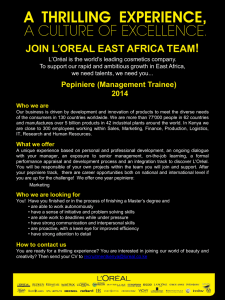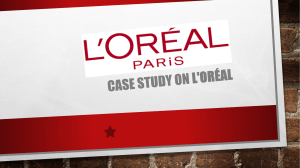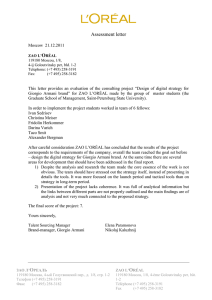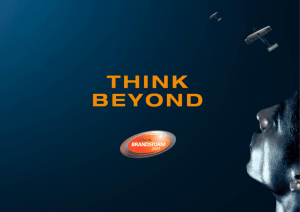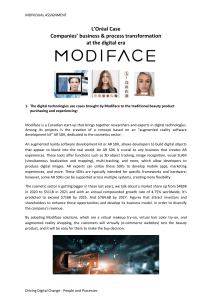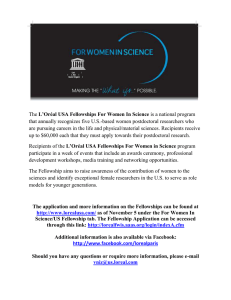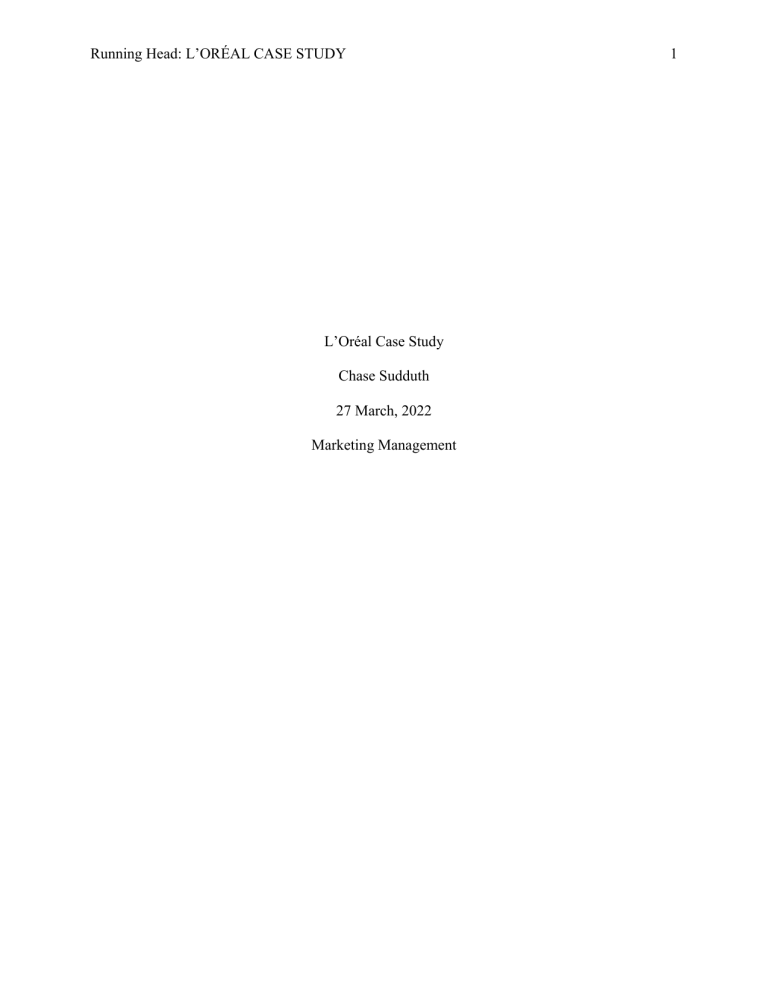
Running Head: L’ORÉAL CASE STUDY L’Oréal Case Study Chase Sudduth 27 March, 2022 Marketing Management 1 L’ORÉAL CASE STUDY 2 BACKGROUND, ISSUES, AND OPPORTUNITIES When attempting to expand business into a new area, there are plenty of different factors that can impact that firm’s success or failure. L’Oréal learned this the hard way after a failed attempt to enter the cosmetics market of India. This would be an unfamiliar result for the already established cosmetics company. Many adjustments needed to be made, yet a major reason that the company did not see immediate success was due to the timing of not having the proper target market in who they would attempt to sell their products to. This market would come later on, following a major size increase of India’s middle class, that saw tremendous growth as the country’s economy, as a whole, began to develop (Shamdasani, 2017). This would open the door for L’Oréal, along with its many competitors, to enter the cosmetic industry that would use the middle class as their primary target market. In the initial attempts that L’Oréal made to establish a flowing business in India, the company portrayed a lack of differentiation from competitors, as well as little understanding for the Indian society and lifestyle. However, as the Indian economy boomed, the middle class grew tremendously, there was a large increase in women joining the workforce, as well as $2.5 billion increase in the cosmetics market between the years of 2011 and 2013 (Shamdasani, 2017). This provided a perfect opportunity for L’Oréal to make another attempt to expand their cosmetic company into India. L’Oréal finally saw some success in their expansion to India, after they decided to take a different approach. After conducting extensive research on what the consumers wanted, the firm shifted their primary focus to hair color products, as well making products that would be widely available for all socioeconomic levels. They utilized many different strategies to market and appeal to consumers and retailers so that they would buy and sell their products. Among these L’ORÉAL CASE STUDY 3 strategies was the idea to clean up retailers in exchange for the store to carry L’Oréal products, as well as leaving the L’Oréal advertisement inside to gain the attention of shoppers. They also participated in local manufacturing, business-to-business marketing, and even developed their own hairdressing school, which contributed to their newly found popularity in India. All of these different efforts would ultimately lead to L’Oréal becoming the number one selling company in the highly competitive hair care market in India. After establishing a positive reputation in India with hair care products like their Easy Rinse shampoo, and many different hair coloring products, L’Oréal decided to expand their horizons into the skincare facet of the industry. They introduced moisturizers, anti-blemish creams, and sun-screens, just to name a few. The company was finding its way in the Indian market which was once difficult for them to navigate, however these many innovations did not give them enough separation from their competitors in the cosmetics market. L’Oréal would not take their foot off the gas, and continued to dedicate their time to researching the most effective ways to appeal to the Indian population. To ensure success, the company opened its own research and innovation laboratories in Mumbai and Bangalore, in order to develop new Indiacentric products (Avantika, 2013). RECOMMENDED STRATEGY One area that is important to consider when attempting to appeal to the people of India, is the fact that they lack an abundant supply of clean water. In a place such as the United States, L’Oréal is not faced with the concerns that their consumers may not have adequate water to use their products, but this is not the case for India. According to the United Nations Children’s Fund, “less than 50 percent of the Indian population has access to safely managed drinking L’ORÉAL CASE STUDY 4 water” (JMP, 2017). This is a problem that directly affects businesses who rely on the use of water for the vast majority of their products. After learning about the problems with attaining clean water in India, it would be wise for L’Oréal to appeal to those who may not have that access. While they have already taken steps in this direction by developing shampoo that only requires two dumps of water in order to rinse it out, what if they made steps in the direction of needing no water at all? L’Oréal should make steps in transitioning their dry shampoo products into India, as compared to Paris where it is primarily developed, at the moment. To add, the increase of production of leave-in conditioner would also benefit the people of India tremendously. An increase of availability in these products would definitely give L’Oréal a boost in popularity after learning about the water troubles that India faces. While it is essential for the haircare products of L’Oréal to require less water, another innovation that L’Oréal should pursue is the creation of waterless skin care and body cleaning products. A simple cleaning product, that comes in the form of a wipe or spray from a wellestablished company, would benefit the Indian people tremendously as it limits the large amounts of chemicals they are exposed to as they use their local water on a daily basis. Making these products, along with the dry haircare products, easily accessible and affordable would likely appeal to a large portion of India’s population. This would not be limited to the typical L’Oréal consumer, which usually consists of women and children, instead all people would be interested in products that helped them maintain good hygiene while also staying healthy at the same time. L’ORÉAL CASE STUDY 5 EXPECTED OUTCOMES After learning of India’s large issue of having a clean and sustainable supply of water for everyone, it is easy to see that the increased production of dry shampoo, leave-in conditioners, and waterless skin care and cleaning products are exceptional alternatives. While these products are mainly targeting the lower income individuals, they are also appealing to higher class individuals as well, as it reduces time necessary for showers and their overall consumption of water. The expansion and improvement of these products are applicable for everyone and would benefit L’Oréal tremendously. These products would be offering a creative solution for individuals unable to properly shower in India. More and more individuals would be able to cleanse themselves regularly regardless of water supply, and L’Oréal would be able to reach their target market in a broader way. These products can be used by all income levels and for the wealthier, convenience would be the biggest advantage. Simple face and body wipes, or haircare products, could be used at lunch or after a long day with minimal time consumption. Meanwhile, the opportunities these waterless products offer are endless for individuals without access to safe water. By introducing dry shampoo into the market, L’Oréal would once again lead the market with innovation and create separation from the competition through the use of waterless sanitary and beauty supplies. Although L’Oréal had already pursued a shampoo that was convenient for various lifestyles and incorporated Indian traditions and needs, water was needed for both products. While attempting to create a more ideal product, it still left some individuals out of reach, the creation of fully dry products leaves nobody behind. Transitioning all the products you L’ORÉAL CASE STUDY 6 use in your daily shower routine to a waterless concept expands L’Oréal’s reach and impacts customers in a great way. RISKS AND MITIGATION PLANS While India has had great troubles with their clean and managed water supply, they have similarly struggled with air quality and in 2019 alone, over 1.5 million deaths in India were attributable to air toxicity (Shetty, 2020). Most dry shampoos in the United States are produced in aerosol cans, only adding to air pollution globally. The best way to combat the risks of aerosols on air pollution would be to aim to develop a dry shampoo that is put into your hair like hair gel, leave-in conditioner, or mousse. By doing so, and taking a more sustainable approach, by making the packaging out of recycled material, L’Oréal will eliminate the risk of aerosols contaminating the air in India, and promote the use of recycled materials. Both of these options together will benefit the environment while also appealing to consumers who are conscious of what they are doing to the environment around them. Although wipes would eliminate the need for individuals to expose themselves to harmful chemicals and toxins, the wipes themselves may create more waste within the country. Despite the issues with water sanitation, India also struggles with waste management, which would not contribute to the environmental improvements that L’Oréal would be aiming to make. India only treats 11.9 million tons out of 43 million tons of municipal waste per year, hinting that the problem is already prevalent (Brunn, 2020). Face and body wipes would only add to the issue if you think of how many people would be using these products and how often. To avoid the risks of added garbage in India, L’Oréal can develop face and body wipes that would decompose in a relatively short period of time and add key nutrients back into the soil. The all-natural ingredients would reduce waste spillage into local water supplies, and L’ORÉAL CASE STUDY eliminate the issue of congesting the waste management system any further. As the wipes decompose, they can provide beneficial nutrients back into the topsoil. The difficulty would be cultivating this type of product, and would be dependent on the cost to do so. Brick making, flooding, and the incorrect elimination of waste and water chemicals has depleted the soil’s organic matter content (Bera, 2020). By developing completely decomposable sanitary wipes and adding nutrients back into India’s soil, L’Oréal will be adding value to the individual and promoting their sustainability efforts. 7 L’ORÉAL CASE STUDY 8 APPENDIX 1 Indian Rupee = 0.013 US Dollars 190,000,000,000 Indian Rupee = 2,524,357,100 US Dollars L’ORÉAL CASE STUDY 9 REFERENCES Bera, S. (2020, July 20). Soil health is degraded in most regions of India. Retrieved April 13, 2021, from https://www.livemint.com/news/india/-soil-health-is-degraded-in-mostregions-of-india-11595225689494.html Brunn, M. (2020, May 06). Waste management crisis in India. Retrieved April 13, 2021 from https://www.recycling-magazine.com/2020/05/06/waste-management-crisis-inindia/#:~:text=Urban%20India%20generates%2062%20million,just%2011.9%20million %20is%20treated. Clean drinking water. (2021, March 24). Retrieved April 13, 2021, from https://www.unicef.org/india/what-we-do/clean-drinkingwater#:~:text=Less%20than%2050%20per%20cent,to%20safely%20managed%20drinki dr%20water. Möller-Gulland, J. (2019, March 26). Toxic water, toxic crops: India's public health time bomb. Retrieved April 13, 2021, from https://www.circleofblue.org/2018/india/toxic-watertoxic-crops-indias-public-health-time-bomb/ NC Climate Education. (n.d.). Retrieved April 13, 2021, from http://climate.ncsu.edu/edu/Aerosols Shamdasani, P. (2017). L'Oréal India: Where beauty meets tradition. National University of Singapore and Richard Ivey School of Business Foundation. Shetty, D. (2020, December 24). Air pollution cost India $36.8 billion in 2019. Retrieved April 13, 2021, from https://www.forbes.com/sites/dishashetty/2020/12/22/air-pollution-costindia-368-billion-in-2019/?sh=613092695c70
